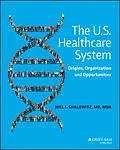Provides a diverse, multi-faceted approach to health care evaluation and management
The U.S. Health Care System: Origins, Organization and Opportunities provides a comprehensive introduction and resource for understanding healthcare management in the United States. It brings together the many "moving parts" of this large and varied system to provide both a bird's-eye view as well as relevant details of the complex mechanisms at work. By focusing on stakeholders and their interests, this book analyzes the value propositions of the buyers and sellers of healthcare products and services along with the interests of patients.
The book begins with a presentation of frameworks for understanding the structure of the healthcare system and its dynamic stakeholder inter-relationships. The chapters that follow each begin with their social and historical origins, so the reader can fully appreciate how that area evolved. The next sections on each topic describe the current environment and opportunities for improvement.
Throughout, the learning objectives focus on three areas: frameworks for understanding issues, essential factual knowledge, and resources to keep the reader keep up to date.
Healthcare is a rapidly evolving field, due to the regulatory and business environments as well as the advance of science. To keep the content current, online updates are provided at: healthcareinsights.md. This website also offers a weekday blog of important/interesting news and teaching notes/class discussion suggestions for instructors who use the book as a text.
The U.S. Health Care System: Origins, Organization and Opportunities is an ideal textbook for healthcare courses in MBA, MPH, MHA, and public policy/administration programs. In piloting the content, over the past several years the author has successfully used drafts of chapters in his Healthcare Systems course for MBA and MPH students at Northwestern University. The book is also useful for novice or seasoned suppliers, payers and providers who work across the healthcare field and want a wider or deeper understanding of the entire system.
Autorentext
JOEL I. SHALOWITZ, MD, MBA, FACP, was Clinical Professor and Director of the Health Industry Management Program at the Kellogg School of Management for 28 years. In addition to practicing internal medicine, he has also been on Northwestern's Feinberg Medical School's faculty for more than 35 years, most recently as Professor of Preventive Medicine. He teaches and consults internationally, was the recipient of three Fulbright awards, and is currently a Senior Fellow at ETLA (the Research Institute of the Finnish Economy) and an Affiliate Professor at the Institute of Management of the Scuola Superiore Sant'Anna in Pisa.
Inhalt
List of Exhibits xiii
Foreword xxi
Acknowledgments xxiii
One: Understanding and Managing Complex Healthcare Systems 1
Definitions 2
Health System Structure and Features 7
Who Pays? 8
How Much Is Paid? 11
Who and What Is Covered? 12
Where Is Care Provided? 13
Who Provides the Services and Products? 14
Strategic Planning 17
Stakeholders 17
Health System Trade-offs and Value Propositions 20
Putting It All Together 30
Summary 32
Two: Determinants of Utilization of Healthcare Services 33
Reasons Stakeholders Seek Healthcare 34
Patient Characteristics That Influence Care-Seeking 36
Age 37
Gender/Sex 37
Race 39
Income 41
Social Status 42
Education 43
Culture and Beliefs 44
Multifactorial Causes 46
Reducing Patient Demand for Healthcare 47
Increase Out-of-Pocket Expenses 47
Prevention 51
Eliminate/Reduce Risky Behaviors 51
End-of-Life Issues 52
Healthy Lifestyle Promotion 54
Consumer BehaviorHealthcare Market Segmentation 54
Provider-Induced Demand for Healthcare 56
Local (Small Area) Variations 61
Summary 63
Three: Managerial Epidemiology 65
Introduction 66
What Is Epidemiology? 66
Why Is It Important to Learn about Epidemiology? 66
Definitions and Uses of Principles 67
Morbidity and Mortality 67
Incidence and Prevalence 67
Validity 67
Reliability 68
Sensitivity, Specificity, Positive Predictive Value, and Negative Predictive Value 68
Clinical Study Designs 70
Case Control Studies 70
Problems with Observational Research 72
Benefits to Employing Observational Research 73
Cohort Study 74
Randomized Controlled Trial 78
Summary 80
Four: Hospitals and Healthcare Systems 81
A Brief History of Western Hospitals 82
American Hospital Expansion in the 20th Century 88
Hospital Definition and Classifications 94
Definition 94
Ways Hospitals May Be Classified and Special Related Issues 96
Hospital Inpatient Payment Methods 137
Organized (Integrated) Delivery Systems/Accountable Care Organizations 139
Origins and Definition 139
Eligibility 143
Financial Arrangements 143
Hospital Governance 153
Definition and Purpose 153
Legal Requirements 154
Responsibilities 156
Board Structure and Activities 159
Summary 161
Five: Healthcare Professionals 163
Physicians 164
History of Western Medical Care 164
History of American Medical Care 177
Current Status of Medical Training 190
Licensure 197
Shortage of Physicians 199
Employment Status 204
Summary 206
Nurses 206
Registered Nurses 206
Nurse Practitioners 208
Nurse Anesthetists 209
Midwives 210
Education and Certification 212
Physician Assistants 213
Education and Certification 214
Physician versus NP/PA Care 215
Summary 216
Six: Payers 219
Principles of Health Insurance 220
The Loss Must Have Some Nontrivial Value Upon Which Both Insured and Insurer Agree 222
The Peril Must Occur Randomly and Be Out of the Control of the Insured 222
The Event Must Occur Neither Too Frequently Nor Too Rarely 225
The Insurer Must Be Able to Write Large Numbers of Contracts to Indemnify Similar Risks 22...
